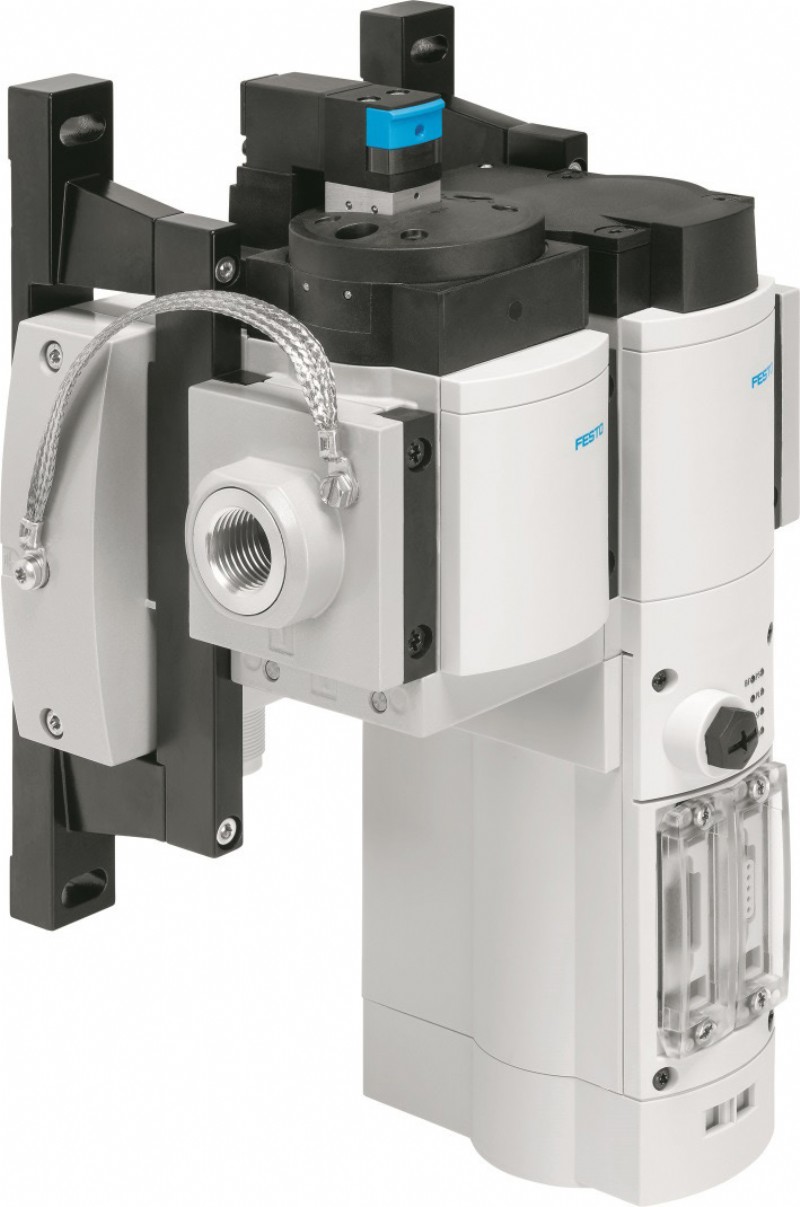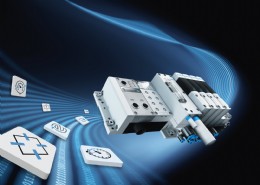Pneumatic Systems as a Genuine Alternative
The importance of considering service life costs in water technology

Saving energy is easy: with its integrated flow rate and pressure sensors, the energy-efficiency module MSE6-E2M automatically reduces and monitors the air consumption of systems.

The brand-new Festo Motion Terminal VTEM catapults the pneumatics into the age of Industry 4.0 – and, for example, permits the opening and closing of process valves with different pressure levels using software apps.
A classic example of a filtration system for a municipal water treatment plant with seven multi-layer filters, seven activated carbon filters and 84 automated process valves revealed that the acquisition costs of a pneumatic system are 28% more advantageous. The acquisition and installation costs included actuators and accessories, installation and commissioning, control components up to the fieldbus interface, as well as energy supply components such as pneumatic actuators, compressor with dryer and air reservoir as opposed to electric actuators with control cabinet elements for energy transfer and safety devices.
Study on power consumption
The project consortium EneffAH, an energy research programme sponsored by the German Federal Ministry for Economic Affairs and Energy, prepared a detailed comparison between pneumatic and electric actuator technology for operating the system. According to this study, modern compressed air systems offer efficiencies of 42%, from generating the air to supplying the actuators. Using a recognised formula, the ratio of usable to consumed power for electric actuators resulted in an efficiency level of 40%.
So why do pneumatic systems offer such cost benefits? Pneumatic actuators only require electricity for regulating and generating compressed air; the movement itself is triggered by the compressed air. By contrast, electric actuators continuously need energy for the electronics, the heating and movement. For the water treatment plant in question the energy costs in comparison to the investment costs are, in any case, negligible.
Overload-proof
In water technology plants, process valves are often actuated only infrequently or not at all for long periods of time. This can lead to the formation of deposits and caking and thus to increased breakaway torques or forces. Pneumatic actuators can overcome this problem simply by increasing the air pressure. They cope well with loads without getting damaged and are not affected by differences in temperature, contamination and humidity. Pneumatic actuators only require electricity for regulating and generating compressed air and act directly on the shut-off valves.
Since pneumatic actuators are overload-proof and a higher actuation force can be achieved very simply by increasing the pressure, it is often possible to use smaller sizes with a lower weight than would be the case for electric actuators. Provided the tubing has zero leakage and the units are precisely dimensioned, the resulting solutions are energy-efficient. Pneumatic systems from Festo are able to deliver high forces of up to 75,000 N and torques of up to 10,000 Nm.
Digitalisation for even greater energy efficiency
The brand-new Festo Motion Terminal VTEM catapults pneumatics into the age of Industry 4.0 ‒ with apps that can replace over 50 individual components. Just as the smartphone turned the mobile communication market on its head a decade ago, so too is the Festo Motion Terminal set to revolutionise automation technology. The new type of function integration – combined with software apps – simplifies the entire value chain, since only one piece of hardware is now required.
With the Motion Terminal, for example, different pressure levels can be used for opening and closing process valves. This can drastically decrease compressed air consumption. In addition, a diagnostic function can be activated after a freely selectable number of switching operations. This function detects any leaks on an actuatorspecific basis and sends specific maintenance messages or shuts down that section of the plant. This makes laborious manual leakage detection in extensive compressed air networks unnecessary.
Energy efficiency perspectives
The energy-efficiency module MSE6-E2M, makes saving energy easy. The integrated flow rate and pressure sensors monitor and automatically reduce the air consumption in systems. The module detects the operating status when no compressed air is consumed, and automatically shuts off the supply. Once the supply is shut off, it checks for any leaks in the system. If there is too much of a drop, the controller is notified. This automatic leakage detection system enables specific maintenance to be carried out, and the continuous monitoring of consumption increases process reliability.
Simple and uncomplicated
Pneumatics is an uncomplicated technology, and is easy to install. Apart from end-position sensing and monitoring the compressed air supply, it doesn’t need to be monitored and checked. It follows the “fit and forget” principle.
Pneumatic actuators have proven to be resistant to vibration and durable. They are made from a small number of components and are thus less likely to break down. Pneumatic actuators are also resistant to continuous loads and remain maintenance-free over their entire service life.
"Unbreakable"
With up to 1 million switching cycles, the average service life of pneumatic actuators is rather impressive. This is true even in harsh environments with high temperature differences, contamination and humidity. Extreme heat or cold and humidity cannot harm corrosionresistant pneumatic components – they are temperature-insensitive between -20 °C and +80 °C, with special low-temperature designs being insensitive down to -40 °C and high-temperature designs up to +120 °C. Components made entirely of stainless steel supplement the product portfolio.
Reduced costs
The low costs mean that it is even worthwhile automating manual process valves at a later date. Specifically when compared to electric actuator technology, the consistent use of decentralised automation concepts with valve terminals provides significant cost benefits – savings of 30% are possible, and in individual cases up to 50%.
Safety first
Pneumatic actuators have three emergency functions – open, closed, stop – in case of a voltage drop. They are ideal for use in ATEX zones, especially when explosion-proof valves, e.g. Namur valves with corresponding coils, are used. It is more cost-effective to position valve terminals outside the explosive zones in non-hazardous areas. The pneumatic standard actuators used in ATEX zones are supplied via tubing while the electronic controls can be installed in the nonhazardous areas. Pneumatic actuators are ATEX-approved up to zone 1 as standard.
Competent, professional advice
Experts from Festo are available to help with the calculation of the compressed air consumption and the optimum layout of the compressed air network, and can also provide support during the tendering process on request. The customer receives everything from a single source – making the order handling process simple and ensuring rapid implementation of the project.
Tel: 01604 667 000
Email: info_gb@festo.com
Web: www.festo.com

| Telephone: | 0800 626422 |
| Email: | info.gb@festo.com |
| Website: | www.festo.com |
| More information on the Festo Ltd BVAA Member Directory Page |
Search related valve / actuator articles: Festo LtdIssue 45ActuatorsRelated ProductsMaster ClassSensors











